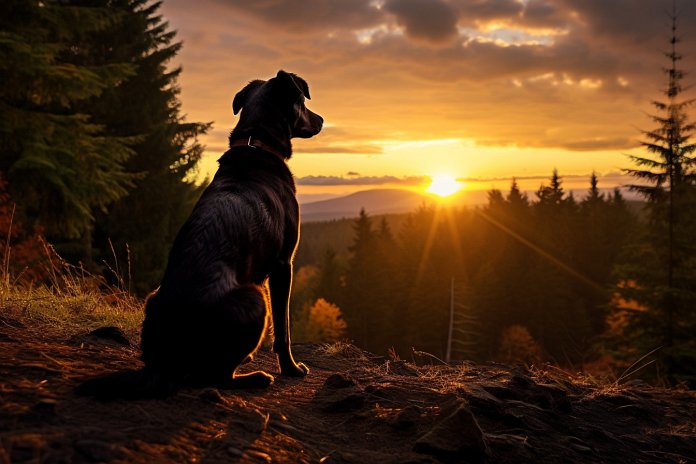
You may already know that dogs can sense danger, as we often see them barking in movies and TV shows when something is not right. But how accurate is this portrayal? Do dogs really have the power to sense danger that humans cannot? Whether it is explained by science or mysticism, dogs do seem to have a knack for sensing danger.
Signs Your Dog is Sensing Danger
Dogs have remarkable senses of smell and hearing, which help them pick up clues to different forms of danger. Once they pick up on these clues, they will react in various ways such as scratching on the door, whining, or barking. Your dog may also act unusually hyperactive, shake, or hide at unusual times. Persistent barking is usually the most noticeable sign, but it’s important to pay attention to other subtle behaviors as well.
If your dog is uncharacteristically following someone, it may be a sign that the person is about to encounter trouble. On the other hand, if your dog responds negatively to someone, especially a stranger, that person may be a source of danger. Knowing your dog’s usual and unusual behavior will help you determine whether they are sensing danger.
Your dog may be trying to signal an impending danger to you. You know your dog best, so you can recognize behavior that is not easily explained by common issues like hunger or fleas. Reacting correctly to your dog’s reaction can be very beneficial.
Body Language
Here are some signs that indicate your dog can sense danger: growling, being alert, barking, whining, guarding, jumping up, and scratching. These behaviors may suggest that your dog is sensing danger and trying to communicate it to you.
Other Signs
Here are some additional signs that your dog can sense danger: erratic behavior, hiding, running away, and restlessness.
History of Dogs Sensing Danger
Dogs have been genetically programmed to survive in the wild, as they have descended from wolves. Throughout history, dogs have impressed humans with their ability to detect danger before it happens. There have been numerous stories of heroic dogs protecting their owners and sounding the alarm in times of danger. These stories continue to be shared today, demonstrating the remarkable abilities of dogs to sense danger.
Science of Dogs Sensing Danger
Scientists have focused on understanding a dog’s ability to sense danger. The closest explanation science has come to is the acute senses of hearing and smell that dogs possess. Dogs can hear frequencies up to 60 Hz, compared to the 20 Hz limit of human hearing. They can also sense changes in barometric pressure, helping them detect storms or other natural disasters. Additionally, dogs may have UV vision, enabling them to see better at night and notice details that humans cannot.
Training Your Dog to Signal Danger
To prepare for potential danger, you should be observant of signs that your dog may be sensing something. Check for any warnings of storms or earthquakes on the TV or news. Assess possible dangers in your surroundings, such as leaving something on the stove or faulty wiring. Reassure your dog and show them that you are paying attention to their behavior. It is important not to discourage their reactions, even if it turns out to be a false alarm, as it may save your life in a genuine emergency. Being a gentle and attentive dog owner can make a significant difference.
Being well-informed about stories of dogs sensing danger can also help you be better prepared. Hearing about other people’s experiences may help you identify potential issues in your area more quickly. If your dog alerts you to actual danger, share your story to benefit others.
“Trust your dog’s instincts – they may be sensing danger that you cannot.”

Tips & Things to Know
1️⃣ Pay attention to your dog’s behavior: If your dog is acting unusually, such as being hyperactive, shaking, or hiding, it could be a sign that they are sensing danger. Other signs to watch for include persistent barking, following someone, or reacting negatively towards a stranger.
2️⃣ Understand your dog’s body language: Growling, alertness, barking, whining, guarding, jumping up, and scratching are all signs that indicate your dog may be sensing danger. It’s important to familiarize yourself with these behaviors so you can recognize when your dog is trying to communicate a potential threat.
3️⃣ Appreciate the science behind dogs sensing danger: Dogs have remarkable senses of smell and hearing, which allow them to pick up on subtle cues that humans may miss. They can hear frequencies higher than humans and may even have UV vision, making them better equipped to detect danger. Understanding the science behind their abilities can help you better appreciate and trust your dog’s intuition.
Frequently Asked Questions, Answered ✅
1. Can dogs really sense danger?
Yes, dogs have a remarkable ability to sense danger due to their acute senses of smell and hearing.
2. What are some signs that a dog is sensing danger?
Signs that a dog is sensing danger include hyperactivity, shaking, hiding, persistent barking, and unusual behavior such as following someone uncharacteristically.
3. How do dogs detect danger?
Dogs can detect danger through their senses of smell, hearing, and potentially even sight. They can pick up on subtle clues and changes in their environment that humans may not notice.
4. Are there specific body language signs that indicate a dog can sense danger?
Yes, some body language signs that indicate a dog can sense danger include growling, being alert, barking, whining, guarding, jumping up, scratching, erratic behavior, hiding, running away, and restlessness.
5. How can I train my dog to signal danger?
To train your dog to signal danger, be attentive to signs that your dog may be picking up on potential danger and take appropriate action. Reassure your dog, check for any actual dangers, and reward their behavior to encourage them to continue alerting you in case of real danger.